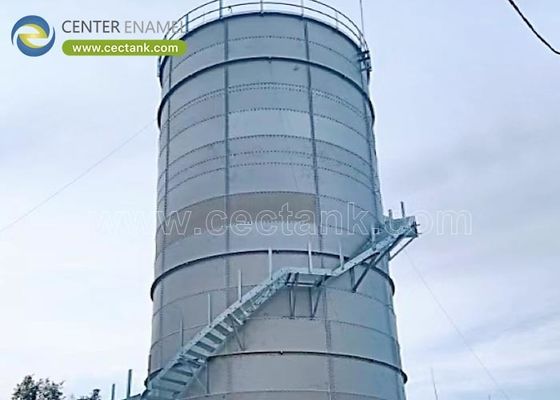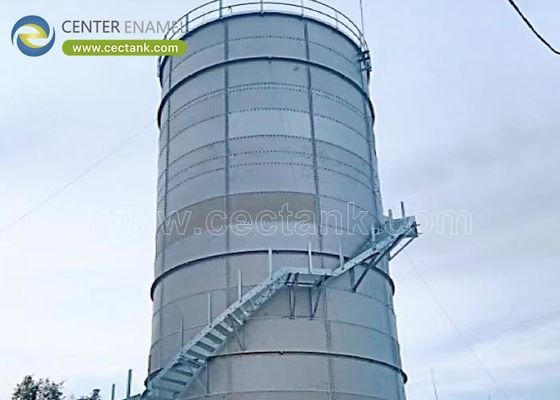-
Tangki Kaca Yang Dilelehkan Ke Baja (419)
-
Tangki Baja Tidak Berlemak (410)
-
Tangki epoxy yang terikat dengan fusi (424)
-
Tangki Baja Galvanis (321)
-
Atap Dome Aluminium (872)
-
Tangki penyimpanan air limbah (226)
-
tangki baja las (297)
-
Kapal Tekanan (295)
-
Pencernaan Anaerobik (201)
-
Tangki Air Industri (349)
-
Tangki baja berlapis kaca (180)
-
Tangki Baja Berbolt (181)
-
Tangki Penyimpanan Lumpur (115)
-
Tangki Penyimpanan Biogas (173)
-
Tangki Penyimpanan Leachate (133)
-
Tangki penyimpanan air pertanian (179)
-
Tangki Air Api (166)
-
Silos Gudang Gandum (130)
-
Proyek Biogas (349)
-
Proyek Pengolahan Air Limbah (270)
-
Atap Membran Ganda (223)
Tangki Baja Tahan Karat untuk Penyimpanan Jagung: Kebersihan, Ketahanan, dan Presisi yang Menguntungkan
| Tempat asal: | Tiongkok |
| Nama merek: | CEC TANKS |
| Sertifikasi: | ISO 9001:2008, AWWA D103 , OSHA , BSCI |
| Nomor model: | W |
| Kuantitas min Order: | 1set |
| Harga: | $5000~$20000 one set |
| Kemasan rincian: | Poli-busa PE di antara masing-masing dua pelat baja; palet kayu dan kayu |
| Waktu pengiriman: | 10-30 hari setelah setoran diterima |
| Syarat-syarat pembayaran: | L/C, T/T |
| Menyediakan kemampuan: | 60 set per bulan |
|
Informasi detil |
|||
Deskripsi Produk
Tangki Baja Tahan Karat untuk Penyimpanan Jagung: Kebersihan, Daya Tahan, dan Presisi yang Menguntungkan
Penyimpanan jagung berada di persimpangan kualitas produk, keamanan pangan, dan ketahanan rantai pasokan. Seiring dengan meningkatnya permintaan global untuk produk berbasis jagung—dari pakan ternak hingga biofuel hingga pati—solusi penyimpanan harus menjaga kadar air, mencegah kontaminasi, dan mendukung penanganan yang efisien. Tangki baja tahan karat menawarkan perpaduan yang menarik antara kebersihan, integritas struktural, dan nilai siklus hidup yang menjadikannya pilihan ideal untuk fasilitas jagung modern. Solusi penyimpanan baja tahan karat Center Enamel memadukan ilmu material canggih dengan desain yang cermat dan penerapan turnkey untuk melindungi jagung dari panen hingga pasar.
Sebagai produsen tangki penyimpanan terkemuka di seluruh dunia. Center Enamel dapat menyediakan tangki Baja Berlapis Kaca (GLS), tangki epoksi terikat fusi, tangki baja tahan karat, tangki baja galvanis, dan atap kubah geodesik aluminium, Peralatan Proyek Air Limbah dan Biogas untuk pelanggan global.
| Konfigurasi Tangki Penyimpanan yang Disesuaikan | ||||
| Tangki penyimpanan | Volume | Atap | Aplikasi | Persyaratan Desain |
|
Tangki GLS Tangki SS Tangki Epoksi Terikat Fusi Tangki Baja Galvanis Tangki Baja Las |
<1000m³ 1000-10000m³ 10000-20000m³ 20000-25000m³ >25000m³ |
Atap ADR Atap GLS Atap Membran Atap FRP Atap Dek Palung |
Proyek Pengolahan Air Limbah Proyek Air Minum Proyek Air Limbah Kota Proyek Biogas Proyek Penyimpanan Air Kebakaran Proyek Penyimpanan Minyak |
Sistem Suplai & Drainase Air Desain Tahan Gempa Desain Tahan Angin Desain Perlindungan Petir Desain Isolasi Tangki |
Pasokan Peralatan Proyek Pengolahan Air Limbah
| Peralatan Pra-perawatan | Sistem Pemanfaatan Sumber Daya | Sistem Pengolahan Lumpur | Peralatan Lainnya |
|
Saringan Batang Mekanik Pemisah Padat-cair Mixer Submersible |
Penampung Gas Sistem Boiler Kipas Pendorong Bio Generator gas Sistem Obor Tangki Dehidrasi dan Desulfurisasi |
Perangkat Dosis Integrasi PAM Mesin Dehidrasi Lumpur Sekrup Sentrifus Pemisahan Lumpur |
Pompa Air Limbah Pengeruk Lumpur Pompa Air Limbah Submersible Pemisah Tiga Fasa |
Mengapa baja tahan karat untuk penyimpanan jagung?
- Kebersihan dan kemudahan pembersihan: Baja tahan karat menyediakan interior yang halus dan tidak berpori yang tahan terhadap penumpukan residu dan ceruk mikroba. Hal ini memungkinkan sanitasi yang lebih cepat di antara batch dan mendukung praktik pembersihan di tempat, yang sangat penting untuk menjaga kualitas dan keamanan jagung di seluruh lini pemrosesan dan saluran ekspor.
- Ketahanan korosi di berbagai iklim: Lingkungan penyimpanan jagung berkisar dari pelabuhan tropis yang lembab hingga fasilitas pedalaman yang gersang. Ketahanan korosi baja tahan karat membantu melindungi integritas penahanan di hadapan kelembapan, paparan garam di dekat garis pantai, dan pencucian rutin dengan bahan sanitasi.
- Keandalan struktural di bawah beban curah: Penyimpanan jagung membutuhkan penahanan yang mampu menahan beban biji-bijian yang berat, aliran dinamis selama pengisian ulang dan pengeluaran, serta tekanan lingkungan seperti gaya seismik atau angin. Tangki dan silo baja tahan karat yang dirancang oleh Center Enamel memberikan kinerja yang andal dengan sambungan yang kuat dan segel yang aman.
- Umur panjang dan ekonomi siklus hidup: Meskipun biaya di muka mungkin lebih tinggi daripada beberapa alternatif, penyimpanan baja tahan karat biasanya menghasilkan biaya siklus hidup yang lebih rendah karena berkurangnya perawatan terkait korosi, umur pakai yang lebih lama, dan nilai biji-bijian yang terpelihara melalui kondisi penyimpanan yang stabil.
- Kompatibilitas kelas makanan dan keselarasan peraturan: Baja tahan karat diterima secara luas dalam industri makanan dan pakan ternak, selaras dengan sistem kualitas global dan persyaratan ekspor, serta menyederhanakan audit dan sertifikasi.
Material, finishing, dan pilihan desain
- Pemilihan kelas: Baja tahan karat 304 adalah dasar umum untuk penyimpanan biji-bijian kelas makanan, menawarkan keseimbangan kinerja dan biaya yang baik. Di lingkungan pesisir atau sangat agresif, baja tahan karat 316 memberikan peningkatan ketahanan korosi.
- Finishing interior: Interior yang dipoles atau satin meningkatkan kemudahan pembersihan, meminimalkan adhesi biji-bijian, dan memfasilitasi sanitasi di antara batch. Finishing yang lebih mengkilap dapat mendukung inspeksi dan pemeriksaan visual cepat selama perawatan rutin.
- Silo versus tangki modular: Untuk penyimpanan jagung, baik konfigurasi seperti silo maupun sistem tangki berbolt modular layak. Desain modular menawarkan perakitan di lokasi yang cepat, kapasitas yang dapat diskalakan, dan ekspansi yang lebih mudah untuk memenuhi puncak panen atau memperluas pasar.
- Ventilasi, aerasi, dan kontrol suhu: Penyimpanan biji-bijian yang efektif bergantung pada aerasi terkontrol untuk mengelola kelembapan dan suhu. Desain harus mengakomodasi kipas, saluran, sensor, dan tindakan pengendalian debu tanpa mengganggu kebersihan interior atau ketahanan korosi.
- Segel, paking, dan sambungan: Paking kelas makanan dan segel presisi memastikan lingkungan terkontrol jika perlu, sambil mempertahankan kemudahan akses untuk pembersihan dan inspeksi.
Pertimbangan desain utama untuk proyek penyimpanan jagung
- Perencanaan kapasitas dan sifat jagung: Perkiraan kapasitas yang akurat harus mempertimbangkan kepadatan curah, kadar air, penyusutan yang diharapkan, dan target umur simpan untuk mengoptimalkan throughput dan meminimalkan kerusakan.
- Dinamika pemuatan dan pembongkaran: Jalur pengeluaran yang efisien, gesekan yang diminimalkan, dan antarmuka yang kompatibel dengan konveyor dan elevator mengurangi waktu penanganan dan konsumsi energi.
- Sanitasi dan kontrol kontaminasi silang: Jika beberapa biji-bijian atau batch berbagi fasilitas, geometri interior, bahan paking, dan kemudahan pembersihan harus meminimalkan kontak silang dan mendukung kepatuhan terhadap peraturan.
- Aksesibilitas dan pemeliharaan: Manway, tangga, indikator level, dan port inspeksi yang ditempatkan dengan baik memungkinkan pemeriksaan dan pembersihan rutin tanpa mengganggu penahanan atau keselamatan pekerja.
- Jaminan kualitas dan keterlacakan: Menyediakan sertifikat material, spesifikasi finishing interior, detail pelapisan (jika berlaku), dan hasil pengujian QA mendukung audit dan kepercayaan pelanggan di seluruh pasar.
Manfaat operasional dan nilai siklus hidup
- Pengawetan kualitas biji-bijian: Interior yang bersih dan tahan korosi mengurangi risiko kerusakan dan kontaminasi, menjaga potensi perkecambahan, kinerja penggilingan, dan nilai pasar.
- Efisiensi throughput: Permukaan interior yang halus dan rute pengeluaran yang dirancang dengan baik meminimalkan resistensi, memungkinkan pembongkaran dan kesiapan pemrosesan yang lebih cepat dan lebih konsisten.
- Disiplin pemeliharaan dan waktu aktif: Pendekatan berbolt modular menyederhanakan ekspansi, perbaikan, atau relokasi, mengurangi waktu henti dan memungkinkan operasi yang gesit.
- Total biaya kepemilikan: Sementara investasi di muka lebih tinggi, penghematan siklus hidup dari sanitasi, daya tahan, dan fleksibilitas kapasitas dapat menghasilkan pengembalian yang menguntungkan selama masa pakai sistem.
Jaminan kualitas dan keselarasan peraturan
- Disiplin manufaktur: Program QA yang ketat mencakup keterlacakan material, kualitas pengelasan dan pemboltan, finishing interior, dan pengujian kebocoran untuk memastikan kinerja yang andal dan kesiapan audit.
- Standar sanitasi: Sejajarkan dengan HACCP, GMP, dan kerangka kerja keamanan pangan regional untuk mendukung pasar ekspor dan ketekunan pelanggan.
- Dokumentasi dan sertifikasi: Berikan sertifikat material, data pelapisan atau finishing permukaan (jika digunakan), dan catatan QA untuk mendukung tinjauan peraturan dan uji tuntas pelanggan.
Aplikasi di seluruh wilayah dan pasar
- Rantai pasokan penggilingan dan pemrosesan: Penyimpanan jagung yang andal mendukung kualitas input yang stabil untuk pabrik, produsen pati, dan fasilitas pakan ternak.
- Pusat ekspor dan distribusi: Penyimpanan baja tahan karat mendukung kontrol sanitasi dan kualitas yang ketat yang diperlukan oleh pembeli dan regulator dalam perdagangan internasional.
- Penerapan yang sadar iklim: Di wilayah dengan kelembapan atau variabilitas suhu, penyimpanan baja tahan karat memfasilitasi integrasi kontrol iklim dan kualitas biji-bijian yang konsisten.
- Penerapan yang fleksibel: Desain modular memungkinkan pertumbuhan kapasitas bertahap yang selaras dengan siklus panen, ekspansi pasar, atau rencana modernisasi fasilitas.
Center Enamel: mitra tepercaya untuk penyimpanan jagung
- Penerapan dan keahlian global: Center Enamel menawarkan pengalaman mendalam dalam solusi penyimpanan baja tahan karat dan berlapis kaca, dengan kemampuan teknik dan layanan di berbagai wilayah dan industri.
- Solusi terintegrasi: Di luar penyimpanan jagung baja tahan karat, Center Enamel menyediakan portofolio sistem tangki yang luas, memungkinkan strategi penyimpanan ujung-ke-ujung yang kohesif untuk berbagai fasilitas.
- Eksekusi yang dipimpin teknik: Dari studi kelayakan dan perhitungan beban hingga pengawasan pemasangan di lokasi dan commissioning, proses tersebut menekankan presisi, keselamatan, dan pengiriman tepat waktu.
- Layanan purna jual dan pemeliharaan: Perencanaan pemeliharaan proaktif, ketersediaan suku cadang, dan dukungan layanan lapangan membantu mempertahankan kinerja puncak dan meminimalkan waktu henti.
Templat studi kasus (penambahan di masa mendatang)
- Koperasi pertanian regional: Jaringan penangan jagung meningkatkan penyimpanan baja tahan karat untuk meningkatkan sanitasi, keterlacakan, dan umur penyimpanan, dengan metrik pada pengurangan kerusakan dan peningkatan throughput.
- Modernisasi terminal ekspor: Fasilitas pelabuhan mengadopsi penyimpanan baja tahan karat dengan aerasi terintegrasi dan pengendalian debu, mencapai perputaran yang lebih cepat dan peningkatan kepatuhan terhadap standar internasional.
- Integrasi pemrosesan: Pabrik pati atau etanol menerapkan penyimpanan jagung baja tahan karat di hulu lini pemrosesan untuk menstabilkan kualitas bahan baku dan meningkatkan stabilitas proses.
Pemasangan, commissioning, dan praktik terbaik pemeliharaan
- Persiapan lokasi: Siapkan fondasi yang kuat atau platform yang ditinggikan yang mengakomodasi panel modular, dengan perhatian pada drainase, utilitas, dan ekspansi di masa mendatang.
- Urutan perakitan: Terapkan pemasangan bertahap, memastikan pemasangan paking, torsi baut, dan penyelarasan panel mengikuti pedoman pabrikan.
- Sanitasi dan commissioning: Lakukan siklus sanitasi dan pengujian kualitas biji-bijian sesuai standar internal dan persyaratan peraturan sebelum memasukkan penyimpanan ke dalam layanan.
- Pemeliharaan berkelanjutan: Jadwalkan inspeksi rutin terhadap segel, sambungan, permukaan interior, dan integritas struktural. Pertahankan catatan komprehensif untuk mendukung audit dan tinjauan kinerja.
Pertimbangan ekonomi dan keberlanjutan
- Ekonomi siklus hidup: Investasi di muka yang lebih tinggi dapat diimbangi oleh penghematan jangka panjang dari daya tahan, pengurangan pemeliharaan, dan nilai biji-bijian yang terpelihara, menghasilkan total biaya kepemilikan yang menguntungkan.
- Manfaat keberlanjutan: Baja tahan karat sangat dapat didaur ulang, dan praktik penyimpanan yang efisien mengurangi limbah terkait kerusakan, selaras dengan target ESG dan harapan pelanggan.
Kesimpulan: Solusi siap masa depan untuk penyimpanan jagung
Tangki baja tahan karat untuk penyimpanan jagung memberikan perpaduan yang menarik antara kebersihan, daya tahan, dan efisiensi throughput. Solusi penyimpanan baja tahan karat Center Enamel menyediakan platform penahanan yang kuat yang mendukung kualitas biji-bijian, kepatuhan terhadap peraturan, dan pertumbuhan yang dapat diskalakan. Dengan menyelaraskan pemilihan material, finishing interior, integrasi aerasi, dan rezim pemeliharaan dengan kebutuhan regional, penyimpanan jagung menjadi aset strategis yang memperkuat ketahanan rantai pasokan dan meningkatkan profitabilitas.




